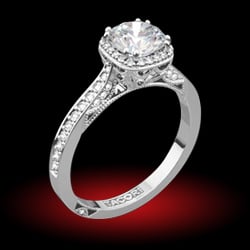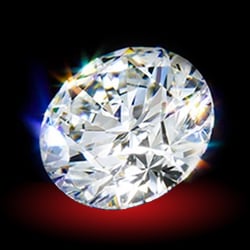- Joined
- Nov 16, 2003
- Messages
- 645
"Honestly, I just don''t believe that the industry can''t come up with (and agree to use) a good, easy to understand grading chart. Artistry aside, I just can''t believe it''s that hard to do or that the equipment doesn''t exist. For crying out loud, we put a man on the moon.."
This question above was raised by "Politely" in a thread about GRS grading terminology. I answered it, or rather dismissed it adequately I thought but the whole question remained niggling in my mind. Politely''s question is an honest one and expresses the frustration of many casual gem buyers who just want a good rock and not a lot of gobbledygook.
So I attempted in the early morning hours to devise a gradng system for blue sapphire. I visualized in my mind the best sapphires I have ever seen and tried to develop a hierarchy to serve as a basis for a system. Well the best sapphires I have ever seen, the quote in all AnA''s posts by Soren Melikin that experts are the sum total of what they have seen kept playing in the back of my mind like an old favorite song.
Simple system with a 1-10 scale. Well since I haven''t seen all sapphires and given that somewhere there is always one better I left #1 blank. Now the best, absolute best (most beautiful) sapphire I have ever seen unfortunatly there were two, one was a Kashmir sapphire, that is it looked like a Kashmir sapphire. Problem is, it came from Sri Lanka! Ok, so what, let that one be #2. The other best stone I have ever seen was a Burma sapphire. The Kashmir colored Sri Lankan stone was a pure powdery blue, the Burma stone had the classic "peacock" purplish blue. They were two different hues (pure blue vs purplish blue) so which is really #2 and which #3?
Next problem: There are really two schools of sapphire aficianados (jump in here any time Dick Hughes) the lighter-tone-brighter and the darker-tone-richer. Now those of you who have read my book would say that I am a member of the darker-richer school. Blue reaches its optimum saturation at 80% tone, therefore, darker sapphires are better. But wait, the absolute best sapphire (Kashmir/Sri Lankan) I have ever seen was more like 75% tone but wonderful saturation.
Maybe my dilema can be solved with a slightly more complex hierarchy? Instead of 1-10 how about A, AA, AAA, AAAA. Well, due to my limited experience and the possibiliy, always present, of a better stone, nothing would be graded AAA. The Kashmir/Sri Lankan stone could be A with a B for number 2, so AB or maybe AAB. Since you can''t have two very different stones with the same grade, the Burma stone could be maybe ABB. Problem now is that the system is becoming rather complex. From a simple 1-10 we now have a triple category system so I supppose I will have to write a fairly long explantion of what the three categories mean after all whats the difference between an ABA and an ACB or a BBA? And, I have yet to consider the other C''s namely Clarity and crystal I suppose I will have to add a couple of extra categories. So maybe I need a five category system like AAAA, ABAAB, what do you think?
Think I''ll have a cup of coffee and give this a bit more thought.
This question above was raised by "Politely" in a thread about GRS grading terminology. I answered it, or rather dismissed it adequately I thought but the whole question remained niggling in my mind. Politely''s question is an honest one and expresses the frustration of many casual gem buyers who just want a good rock and not a lot of gobbledygook.
So I attempted in the early morning hours to devise a gradng system for blue sapphire. I visualized in my mind the best sapphires I have ever seen and tried to develop a hierarchy to serve as a basis for a system. Well the best sapphires I have ever seen, the quote in all AnA''s posts by Soren Melikin that experts are the sum total of what they have seen kept playing in the back of my mind like an old favorite song.
Simple system with a 1-10 scale. Well since I haven''t seen all sapphires and given that somewhere there is always one better I left #1 blank. Now the best, absolute best (most beautiful) sapphire I have ever seen unfortunatly there were two, one was a Kashmir sapphire, that is it looked like a Kashmir sapphire. Problem is, it came from Sri Lanka! Ok, so what, let that one be #2. The other best stone I have ever seen was a Burma sapphire. The Kashmir colored Sri Lankan stone was a pure powdery blue, the Burma stone had the classic "peacock" purplish blue. They were two different hues (pure blue vs purplish blue) so which is really #2 and which #3?
Next problem: There are really two schools of sapphire aficianados (jump in here any time Dick Hughes) the lighter-tone-brighter and the darker-tone-richer. Now those of you who have read my book would say that I am a member of the darker-richer school. Blue reaches its optimum saturation at 80% tone, therefore, darker sapphires are better. But wait, the absolute best sapphire (Kashmir/Sri Lankan) I have ever seen was more like 75% tone but wonderful saturation.
Maybe my dilema can be solved with a slightly more complex hierarchy? Instead of 1-10 how about A, AA, AAA, AAAA. Well, due to my limited experience and the possibiliy, always present, of a better stone, nothing would be graded AAA. The Kashmir/Sri Lankan stone could be A with a B for number 2, so AB or maybe AAB. Since you can''t have two very different stones with the same grade, the Burma stone could be maybe ABB. Problem now is that the system is becoming rather complex. From a simple 1-10 we now have a triple category system so I supppose I will have to write a fairly long explantion of what the three categories mean after all whats the difference between an ABA and an ACB or a BBA? And, I have yet to consider the other C''s namely Clarity and crystal I suppose I will have to add a couple of extra categories. So maybe I need a five category system like AAAA, ABAAB, what do you think?
Think I''ll have a cup of coffee and give this a bit more thought.


















300x240.png)